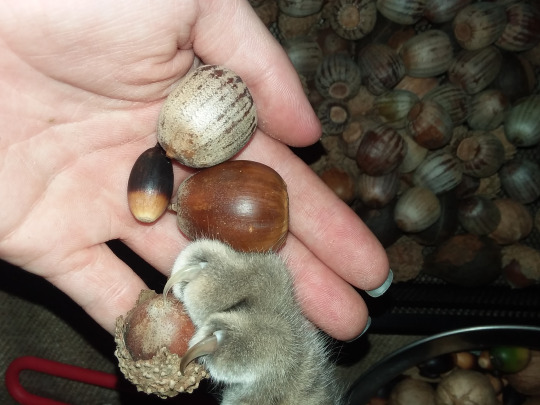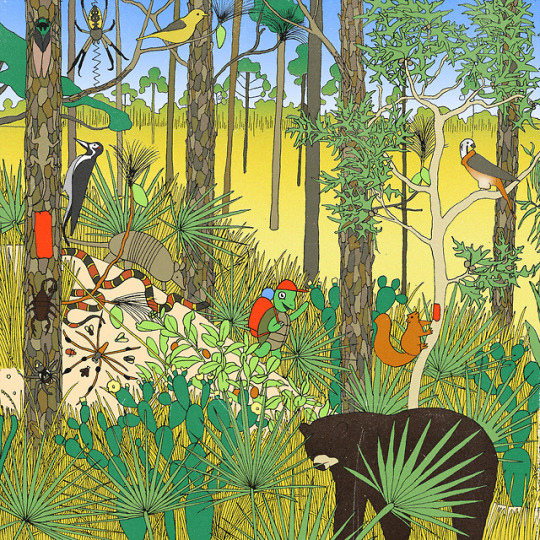#Quercus michauxii
Explore tagged Tumblr posts
Text
Kairiz "helping" me take pictures of seeds I collected
Jumping up onto the couch right as I took a picture with flash on:

[ID: A flash photo of a grey cat tilting his head back to look up at the camera, his eyes reflecting bright yellow with green pupils. Below him in the shadowy background are plates and baskets with various acorns and nuts on them. End ID.]
Deciding he wants the exact acorn I am holding right as I take the picture:

[ID: A photo of a white hand holding four types of acorns: Live oak, which is the smallest, being long and skinny, with a shiny black shell that is tan where the cap was. Shumard oak, which is large and boxy, brown, and covered with a light grey dusting. Swamp chestnut oak, which is the largest, shiny deep brown, tall and fat. And overcup oak, which is round, and still covered by its thin, bumpy cap. A grey cat's paw is dragging the overcup acorn off the hand, claws extended to catch onto the cap. End ID.]
And sticking his face directly in the way:

[ID: A flash photo of the back of a grey cat's head as he sniffs a purple organza bag filled with large dark acorns, blocking most of the view with his head and ears. End ID.]
outdoor cat people DNI, you'll just be blocked. We care about pets and the environment here, honoric of your choice. Keeping cats outdoors is animal abuse and causing more native species to go extinct.
Keep your cats inside so they can "help" you catalogue the different species in your area by playing with everything you bring home, instead of bringing you dead native birds.
#Kairiz the cat#cats#described images#southern live oak#Quercus virginiana#WHIC IS A RIP OFF NAME!!!#Shumard oak#Quercus shumardii#at least makes sense#Swamp chestnut oak#Quercus michauxii#I assume that was named after whoever described it#Overcup oak#Quercus lyrata#that's a pretty name#oaks#acorns#iNaturalist#Rjalker does iNaturalist#long post
5 notes
·
View notes
Photo

Swamp chestnut oak (Quercus michauxii)
#swamp chestnut oak#conservation status: least concern#Plantae#Angiosperms#Eudicots#Rosids#Fagales#Fagaceae#Quercus#Quercus michauxii#trees#oak trees#Nikon D3400#nikonphotography#my flora#nature photography#photographers on tumblr#Black Bayou Lake National Wildlife Refuge#Quercus houstoniana#endemic flora of the United States#trees of the Eastern United States#trees of the Southeastern United States#flora
4 notes
·
View notes
Text
The conclusion that my fb plant id group came to is that this must be Q. michauxii. Reasons include the shape of the base of the leaves (compare to the flats attachment of Q. montana, pictured below) and the fact that lower leaves are often wider than higher "typical" leaves.




Plant friends, can anyone positively id this oak? This is central North Carolina, USA, pictures taken a couple days ago. It grows on a high bank by the river.
Candidates I came up with are are Quercus montana (chestnut oak), Q. michauxii (swamp chestnut oak), and Q. meuhlenbergii (chinkapin oak). I'm open to others, of course, as these all seem wrong.
Q. montana was my first thought, and I still think the leaves look like that, but the bark is entirely wrong, both in comparison with reference photos and with other locals specimens I've seen in person. For Q. michauxii, the leaves seem wrong, in both texture/shininess and width. Q. meuhlenbergii seems the least likely, as it should have pointed leaf lobes and shouldn't naturally occur in this county (though it being planted at this location is possible).
13 notes
·
View notes
Text
Oak Correspondences & Associations
This is the only post y'all are getting today because oak was a pain in the butt to write down EVERYTHING for.
Like with the other categories of trees we've covered, there are many oak species that can be found in Missouri, such as the following white oaks:
quercus alba (white oak)
quercus bicolor (swamp white oak)
quercus lyata (overcup oak)
quercus macrocarpa (blue/bur/burr/mossycup/mossycup white/scrub oak)
quercus michauxii (swamp chestnut oak)
quercus muehlenbergii (chinkapin oak, chinkapin)
quercus prinoides (dwarf chestnut/dwarf chinkapin/dwarf chinquapin/scrub chestnut oak)
quercus stellata (iron/post oak)
And the following red oaks:
quercus acutissima (sawtooth oak)
quercus coccinea (scarlet oak)
quercus falcata (bottomland red/southern red/spanish/three-lobed red oak)
quercus imbricaria (shingle oak)
quercus marilandica (blackjack oak)
quercus nigra (water oak)
quercus pagoda (cherrybark oak)
quercus palustris (pin/swamp spanish oak)
quercus phellos (willow oak)
quercus rubra (champion/northern red/red oak)
quercus shumardii (schneck/shumard/shumard red/spotted/swamp red oak)
quercus texana (nuttall/nuttall's oak)
quercus velutina (black/eastern black oak)
And there are probably way more! But I am tired of looking at Latin oak names and there's way more we have to cover in this post!
ASSOCIATIONS
Animals
bee
boar
chameleon
cicada
horse (white)
oriole
wolf
woodpecker
wren
Comets & Planets
Jupiter [especially acorns]
Mars [red]
Moon [white]
Sun [especially wood]
Deities & Figures
Aegir (Norse)
Angrboda (Norse)
Apollo (Greek)
Ares (Greek)
Artemis (Greek)
Asherah (Semitic)
Athena (Greek)
Baldr (Norse)
Bilé (Irish)
Brahma (Hindu)
Brigid (Irish)
Ceres (Greek)
Cernunnos (Gaulish)
Cerridwen (Welsh)
Cybele (Anatolian)
the Dagda (Irish)
Demeter (Greek)
Diana (Roman)
Dôn (Welsh)
Donar (Germanic, Saxon)
Erato (Greek)
Fortuna (Roman)
Green Man
Hades (Greek)
Hekate (Greek)
Helios (Greek)
Hera (Greek)
Hercules (Roman)
Herne (English)
Horned God (Wicca)
Horus (Egyptian)
Janus (Roman)
Jove (Roman)
Jupiter (Roman)
Mars (Roman)
the Morrigan (Irish)
Odin (Norse)
Pan (Greek)
Perkūnas (Baltic)
Perun (Slavic)
Pluto (Roman)
Rhea (Greek)
Svarog (Slavic)
Taara (Estonian)
Taranis (Gaulish)
Thor (Norse)
Ukko (Finnish)
Vishnu (Hindu)
Zeus (Greek)
Elements
air
earth
fire [especially wood]
Entities
ancestors
Balanos (Greek)
deities
druids
dryads
elves
fae [especially acorns, twigs]
hamadryads
spirits
spirit guides
Genders
masculinity [especially wood]
nonbinary genders
trans femininity
trans masculinity
Holidays
Autumn Equinox
Beltane [especially acorns]
Litha [especially leaves]
Lughnasadh
Mabon
Midsummer’s Eve
Summer Solstice
Walpurgis Night
Yule
Zodiac Signs
Aries
Cancer
Gemini
Leo
Sagittarius
Virgo
CORRESPONDENCES
abundance [especially acorns, acorn caps]
afterlives/otherworlds
attraction
authority
awareness
beauty [acorns]
being the best version of yourself
blessing
cleansing [especially white]
confidence
consecration
courage [especially acorns]
death
dedication
deduction in sexual desire [decayed acorns, rotted acorns]
defense [especially wood]
determination
divination
divine energy
enchantment
endurance
energy work
family
family unity [sprigs]
feeling at ease
feeling one’s age [decayed, rotted]
fertility [especially acorns, acorn flour, acorn symbols, white, wood]
finances
financial gain [acorn symbols]
financial success [acorns]
focus
funerary practices
good fortune [especially acorns, acorn symbols]
good health [acorns, acorn caps]
good luck [acorns, acorn caps, wood]
great ideas [acorn symbols]
grounding [bark]
growth [acorns]
harmony
healing [especially acorns, acorn flour, wood]
health [especially acorn flour, white, wood]
home
hunting [especially acorns]
inspiration
justice
leadership
legal matters
lightning [wood]
long-term determination
longevity [especially acorns, acorn caps]
luck [especially acorns, acorn flour, acorn symbols, wood]
manifestation [especially acorns]
might
money [especially acorns, acorn flour, wood]
new beginnings [acorn symbols]
new ventures [acorns]
nurturing [acorns]
offering [leaves, wood]
opening
opening doors
overcoming challenges/obstacles
patience
perseverance
personal power [acorns, acorn flour]
personal sovereignty
potency [especially acorns, acorn flour, wood]
power [especially acorns, wood]
prophecy
prosperity [especially acorns, wood]
protection [especially acorns, acorn flour, leaves, wood]
protection from bad weather [especially acorns]
protection from evil
protection from fae [bundled twigs]
protection from fire
protection from floods [acorns]
protection from harm [especially acorns]
protection from lightning [especially acorns]
purification [especially leaves]
removing negativity
renewal
rulership
safety [acorns]
savings [acorn symbols]
sealing doors
secrets
security [acorns, acorn caps]
sex
sexuality
solidity [white]
spirit work
spirituality
stability [wood]
steadfast knowledge [leaves]
strength [especially acorns, bark, white, wood]
strengthening the threshold
studying [especially acorns]
success [especially acorn symbols, wood]
success in school/work
transition
truth [leaves]
uncrossing [white]
unlimited/unseen potential [acorns]
victory
victory in battles/war
warding
warding off evil [twigs]
warding off illness [acorns]
warding off malevolent spirits
warding off negativity [especially sprigs]
wealth [especially acorn flour]
wisdom [especially acorns, acorn flour]
youthfulness [especially acorns, acorn caps]

#jasper post#missouri magic#missouri magick#missouri paganism#missouri pagan#missouri witchcraft#missouri witch#missouri#herbs and other plants#correspondences and associations#oak
34 notes
·
View notes
Photo

4/5 of the ecosystems I’ve illustrated for the Florida Trail Association! This one is the xeric sandhill scrub, which is common throughout north and central Florida, like the Juniper Prairie Wilderness in Ocala National Forest. Species listed: Fauna Twin-flagged jumping spider (Anasaitis canosa) Black and yellow garden spider (Argiope aurantia) Golden orbweaver spider (Nephila clavipes) Dog-day cicada (Tibicen canicularis) Florida bark scorpion (Centruroides gracilis) Fence lizard (Sceloporus undulatus) Eastern coral snake (Micrurus fulvius) Red-cockaded woodpecker (Picoides borealis) Southeastern kestrel (Falco sparverius paulus) Pine warbler (Setophaga pinus) Florida black Bear (Ursus americanus floridanus) Eastern gray squirrel (Sciurus carolinensis) Flora Gopher apple (Licania michauxii) Prickly Pear Cactus (Opuntia austrina) Longleaf Pine (Pinus palustris) Saw Palmetto (Serenoa repens) Turkey Oak (Quercus laevis) Wiregrass (Aristida stricta)
13 notes
·
View notes
Text
Quercus michauxii
Swamp Chestnut Oak
Height: 50ft-60ft
Spread: 40ft-60ft
Native: L48
Kingdom: Plantae (plants)
Subkingdom: Tracheobionta (vascular plants)
Superdivision: Spermatophyta (seed plants)
Division: Magnoliophyta (flowering plants)
Class: Magnoliopsida (dicotyledons)
Subclass: Hamameliddae
Order: Fagales
Family: Fagaceae
Genus: Quercus L.
Large, palmately compound leaves
Provides dense shade
Grows small fruit that attracts squirrels
High drought tolerance
Photographed at Stetson West Dorm, Boston, MA
Prefers full solar exposure
Prefers medium textured soil
Prefers low moisture level
Cold hardiness zones 5-9
Sources: https://plants.sc.egov.usda.gov/core/profile?symbol=QUMI
https://edis.ifas.ufl.edu/st557




0 notes
Photo






White Oak (Quercus alba)
Mature Size - (50-80′ x 50-80′) Occasionally grows over 100′ tall.
Shape and Form - Large tree. Pyramidal when young, but matures into a substantial tree with a wide-spreading, rounded crown. Branching can be irregular and quite interesting.
Growth Habit - Slow to medium growth rate.
Leaves - Typical oak leaf shape, in the white oak group. Rounded lobes. Leaves emerge pinkish in spring, but mature to dark green. Variable fall color ranges from uninteresting browns to quality shades of dark red.
Flowers - Insignificant yellowish-green flowers in separate male and female catkins appear in spring shortly after the leaves emerge.
Fruit/Seeds - Fruits are oval acorns (to 3/4" long) with warty-scaled cups. Leaves (4-9" long) have 7 to 9 deep rounded lobes.
Bark - White or light gray bark is somewhat flaky.
Region - USA native. Native to eastern North America.
Hardiness Zones - (3-9)
Habitat/Growing Conditions - Typically occurs in dry upland slopes and ledges as well as lowland valleys and ravines. Best grown in rich, moist, acidic, well-drained loams in full sun. Adapts to a wide variety of soil conditions with good drought tolerance. Will tolerate drought, clay soil, dry soil, and shallow rocky soil.
Plant Community - NA
Eco-indicator - NA
Other info - White Oak features a high level of genetic variability among the species.
An important timber tree, White Oak wood is heavy, hard, strong, and durable. An important source of wood for furniture, veneer, paneling, and flooring.
The young shoots of many eastern oak species are readily eaten by deer. Dried oak leaves are also occasionally eaten by white-tailed deer in the fall or winter. Rabbits often browse twigs and can girdle stems. The porcupine feeds on the bark, and beavers eat twigs of White Oaks. Acorns of White Oak are considered choice food for many wildlife species, including the white-footed mouse, fox squirrel, black bear, pine mouse, red squirrel, and cottontail rabbits. The gray squirrel consumes white oak acorns but prefers the acorns of other oak species. Many birds, including the bluejay, northern bobwhite, mallard, ring-necked pheasant, greater prairie chicken, ruffed grouse, and wild turkey, eat white oak acorns. In some areas, the abundance of fall mast crops, such as acorns, can affect black bear reproductive success during the following year. Sprouted acorns are often eaten by deer, mice, and bobwhite.
Current Nursery Status and Availability - Easily available in nursery trade. Dirr lists a single cultivar of this species in his 6th edition woody plants manual:
‘Southern Cross’ - A unique hybrid between Quercus alba and Quercus michauxii. Features rapid growth rate, strong central leader, graceful branching habit, and tolerance of periodically flooded soil.
http://www.missouribotanicalgarden.org/PlantFinder/PlantFinderDetails.aspx?kempercode=l930
https://www.fs.fed.us/database/feis/plants/tree/quealb/all.html
http://hort.uconn.edu/detail.php?pid=377
Dirr - “Manual of Woody Landscape Plants”
Wessels - “Reading the Forested Landscape”
#zone3#zone4#zone5#zone6#zone7#zone8#zone9#USA native#large tree#slow growth rate#high wildlife value#tolerates drought#difficult to transplant#oak
0 notes
Text









ACORNS!!!
Swamp chestnut oak observation on iNaturalist
#undescribed images#swamp chestnut oak#caps lock#oaks#quercus#Quercus michauxii#August#plants#trees#nature
1 note
·
View note
Text
the same acorn 88 days later
day 1:

[ID: A photo of an immature swamp chestnut oak acorn in a tree facing the camera. The cap is bumpy and light green, and almost completely covers the light green acorn developing inside except for a small circle at the bottom. End ID.]
day 88:

[ID: A photo of the same acorn, now much larger, with the cap light brown, and the acorn having expanded and grown so it is now very large. It is almost yellow in color, with more tan near the very bottom. The leaves around it are starting to change color. End ID.]
The tree's started dropping other acorns, so if I'm lucky I'll be able to find this one when it falls too, lol...
1 note
·
View note
Photo



Swamp chestnut oak (Quercus michauxii), which has sweet acorns.
2 notes
·
View notes
Text



Plant friends, can anyone positively id this oak? This is central North Carolina, USA, pictures taken a couple days ago. It grows on a high bank by the river.
Candidates I came up with are are Quercus montana (chestnut oak), Q. michauxii (swamp chestnut oak), and Q. meuhlenbergii (chinkapin oak). I'm open to others, of course, as these all seem wrong.
Q. montana was my first thought, and I still think the leaves look like that, but the bark is entirely wrong, both in comparison with reference photos and with other locals specimens I've seen in person. For Q. michauxii, the leaves seem wrong, in both texture/shininess and width. Q. meuhlenbergii seems the least likely, as it should have pointed leaf lobes and shouldn't naturally occur in this county (though it being planted at this location is possible).
#plant id#plant identification#tree identification#oak#oak tree#i am aware of oaks' troublesome tendency to hybridize#but I'm hoping for a solid answer i haven't thought of#trees#leaves#green#spring#in case i forget - it's by the old racetrack
13 notes
·
View notes